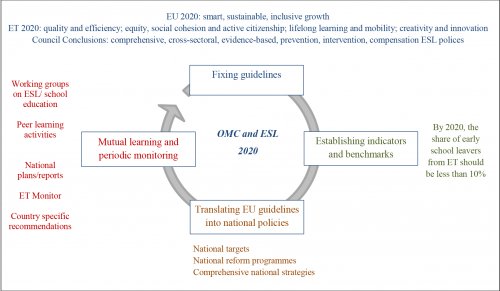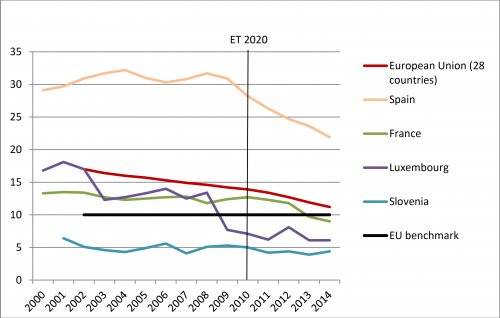

ESL in the EU: Policy overview and development
Thursday 23 July 2015, by
In the OMC process the EU’s strategic goals on ESL are framed, measured by specific indicators and benchmarks (by 2020 the share of ESLers should be less than 10%), translated into national ESL policies and periodically monitored. Knowing and understanding this process among all relevant actors is crucial for their more proactive involvement in ESL policy-making and contributing to good governance in the EU.
The European educational space has widened and deepened in the last two decades, which can also be recognised in the field of ESL (e.g. Walkenhorst, 2008). Since 2000, when the Open Method of Coordination (OMC) was formally established as the framework for EU cooperation in the field of education, member states have been working intensively together in order to attain their common goal/benchmark “to reduce ESL to less than 10% by 2020”. The article systematically presents the normative framework of the EU cooperation in the ESL field in the last 20 years according to the OMC elements defined in Presidency Conclusions (2000) and illustrates how these elements have been put to good use in TITA EU member states (France, Luxemburg, Spain and Slovenia). The review presents examples of various general directions (e.g. Council Recommendations) as well as concrete policy and practical recommendations (e.g. Toolkits) for how to tackle ESL at the individual, school, local, regional, national and EU levels. The way EU member states transpose these EU guidelines into national policies (e.g. by setting national targets and publishing national strategies) is described along with the OMC policy learning framework (e.g. thematic working groups and policy learning activities) within which member states search for solutions to a commonly identified problem and share their related (good) practices. Finally, the role of regular (quantitative and qualitative) reporting in stimulating member states to achieve the commonly agreed goal is emphasised. The article concludes that for OMC to be an open, participative, accountable, effective and coherent process, contributing to good governance in the EU, all relevant actors in its process at all levels of the EU need to be more involved. Referring to different research findings (e.g. Lajh & Štremfel, 2011; Ecorys, 2014) this could also be ensured by better awareness of the potential of OMC, as presented in this article.
[1] Since Switzerland is not formally an EU member state, its involvement in the OMC processes is quite limited. According to different agreements, Switzerland is involved in various comparative studies and is an eligible country to receive financial support from various EU financial initiatives contributing to the development of educational policies and practices at the national level. Due to its constrained role in the OMC processes, practical insights into the reception of EU agendas in Switzerland in this article are very limited.
[2] Although ESL has been recognised as one of the priority areas of common EU cooperation since 2002, the article takes into account the second strategic framework of EU cooperation in the field of education (EU 2020 and ET 2020). References to their predecessors (Lisbon Strategy and ET 2010) are established only when needed to clarify some current issues. The reason for that is at least threefold: 1) EU 2020 and ET 2020 build on the achievement of the previous working period (2000–2009); 2) availability of the data from the previous working period is quite limited; and 3) the TITA project addresses the strategic priorities of the second working period (EU 2020 and ET 2020).
[3] The Council wanted a strategic framework that would remain flexible enough to respond to new challenges and could therefore be regularly adapted. This is the reason for ET 2020’s 3-year work cycles with Joint Reports (adopted by the Council and the Commission) as a basis for establishing fresh priority areas for the ensuing cycle. An overview shows that ESL has been identified as a priority area in all three already activated cycles 2009–2011, 2012–2014 and 2015–2017. For example, in the current cycle (2015–2017) as a concrete issue in addressing one of the priority areas it is stated “Reducing ESL by supporting school-based strategies with an overall inclusive learner-centred vision of education and ‘second-chance’ and “Supporting initial education and continuing professional development at all levels, especially to deal with /…/ ESL /…/”. Review of the National Report on the implementation of ET 2020 in which member states were asked to point out priority areas which they find necessary to focus EU cooperation in the next working cycle (2015–2017) on reveals that all TITA countries actually conducting the (formally non-obligatory) report (France, Luxembourg, Slovenia) exposed the importance of strengthening EU cooperation on ESL from different angles.
[4] Two of the six working groups (Working group on schools; Working group on promoting citizenship and the common values of freedom, tolerance and non-discrimination through education – follow-up to the Paris Declaration) only indirectly indicate ESL as a Relevant Europe 2020 target/ET 2020 benchmark, which their work is related to.
[5] Another kind of reports, providing cross-national comparisons and important expert input to the OMC process, are various reports of expert bodies or networks (such as NESSE, 2010; European Parliament, 2011; EENEE, 2013; Eurydice, 2014).
Alexiadou, N. (2007). The Europeanisation of education policy – changing governance and »new modes of coordination«. Research in Comparative and International Education, 2(2), 102–116.
Alexiadou, N., & Lange, B. (2013). Deflecting European Union influence on national education policy-making: The case of the United Kingdom. Journal of European Integration, 35(1), 37–52.
Alexiadou, N., Fink Hafner, D., & Lange, B. (2010). Education policy convergence through the Open Method of Co-ordination (OMC): Theoretical reflections and implementation in »old« and »new« national contexts. European Educational Research Journal, 9(3), 345–358.
Borrás, S. & Radaelli, C. M. (2010). Recalibrating the Open Method of Coordination: Towards diverse and more effective usages. Stockholm: Swedish Institute for European Policy Studies, SIEPS Working Paper, No. 2010: 7.
Büchs, M. (2008). How legitimate is the Open Method of Co-ordination? Journal of Common Market Studies 46(4): 765–786.
Dehousse, R. (2002, September). The Open Method of Coordination: A new policy paradigm? Paper presented at the First Pan-European Conference on European Union Politics »The Politics of European Integration: Academic Acquis and Future Challenges«, Bordeaux, France.
Council of the EU. (2001). Report from the Education Council to the European Council »The concrete future objectives of education and training systems«. Retrieved from http://ec.europa.eu/education/policies/2010/doc/rep_fut_obj_en.pdf
Council of the EU. (2002). Working programme Education and Training 2010. Retrieved from http://eur-lex.europa.eu/LexUriServ/LexUriServ.do?uri=OJ:C:2002:142:0001:0022:EN:PDF
Council of the EU. (2009). Council conclusions of 12 May 2009 on a strategic framework for European cooperation in education and training (“ET 2020”). Retrieved from http://eur-lex.europa.eu/legal-content/EN/TXT/PDF/?uri=CELEX:52009XG0528(01)&from=EN
Council of the EU. (2011). Council Recommendation on policies to reduce early school leaving. Retrieved from http://eur-lex.europa.eu/legal-content/EN/TXT/PDF/?uri=CELEX:32011H0701(01)&from=EN
Council of the EU. (2015). Council conclusions on reducing early school leaving and promoting success in school. Retrieved from http://eur-lex.europa.eu/legal-content/EN/TXT/PDF/?uri=CELEX:52015XG1215(03)&from=EN.
Council of the EU and European Commission. (2012). 2012 Joint Report of the Council and the Commission on the implementation of the Strategic Framework for European cooperation in education and training (ET 2020) “Education and Training in a smart, sustainable and inclusive Europe”. Retrieved from http://eur-lex.europa.eu/legal-content/EN/TXT/PDF/?uri=CELEX:52012XG0308(01)&from=EN
Ecorys. (2014). Interim evaluation of the strategic framework for European cooperation in education and training (ET 2020). Retrieved from http://ec.europa.eu/dgs/education_culture/more_info/evaluations/docs/education/et2020_en.pdf
EENEE (European Expert Network on Economics of Education). (2013). The costs of early school leaving in Europe. Retrieved from http://www.eenee.de/eeneeHome/EENEE/Analytical-Reports.html
European Council. (2000). Lisbon European Council 23-24 March 2000. Presidency Conclusions. Retrieved from http://www.europarl.europa.eu/summits/lis1_en.htm
European Commission. (2001). European governance. A white paper. Retrieved from http://eur-lex.europa.eu/LexUriServ/site/en/com/2001/com2001_0428en01.pdf
European Commission. (2002). Communication from the Commission: European benchmarks in education and training: follow-up to the Lisbon European Council. Retrieved from http://eur-lex.europa.eu/LexUriServ/LexUriServ.do?uri=COM:2002:0629:FIN:EN:PDF
European Commission. (2010). Communication from the Commission: Europe 2020 A strategy for smart, sustainable and inclusive growth. Retrieved from http://ec.europa.eu/eu2020/pdf/COMPLET%20EN%20BARROSO%20%20%20007%20-%20Europe%202020%20-%20EN%20version.pdf
European Commission. (2011a). Reducing early school leaving, Commission Staff Working Paper.
European Commission. (2011b). Communication from the Commission to the European Parliament, the Council, the European Economic and Social Committee and the Committee of the Regions Tackling early school leaving: A key contribution to the Europe 2020 agenda.
European Commission. (2013). Reducing early school leaving: Key messages and policy support. Final Report of the Thematic Working Group on Early School Leaving. Retrieved from http://ec.europa.eu/education/policy/strategic-framework/doc/esl-group-report_en.pdf
European Commission. (2015). Education & Training 2020. Schools policy A whole school approach to tackling early school leaving Policy messages. Retrieved from http://ec.europa.eu/education/policy/strategic-framework/expert-groups/documents/early-leaving-policy_en.pdf
European Commission. (2012). Communication from the Commission to the European Parliament, the Council, the European Economic and Social Committee and the Committee of the Regions Rethinking Education: Investing in skills for better socio-economic outcomes. Retrieved from http://eur-lex.europa.eu/legal-content/EN/TXT/PDF/?uri=CELEX:52012DC0669&from=EN
European Commission. (2015). Education and Training Monitor. Retrieved from https://ec.europa.eu/education/library/publications/monitor15_en.pdf
European Commission. (2016). Early school leaving. Retrieved from http://ec.europa.eu/education/policy/school/early-school-leavers_en.htm
European Commission/EACEA/Eurydice (2013). Education and Training in Europe 2020: Responses from the EU Member States. Eurydice Report. Brussels: Eurydice.
EC/EACEA/Eurydice/Cedefop. (2014). Tackling Early Leaving from Education and Training in Europe: Strategies, Policies, and Measures. Eurydice and Cedefop Report. Luxembourg: Publications Office of the European Union.
European Parliament. (2011). Reducing early school leaving in the EU. Study. Retrieved from http://www.europarl.europa.eu/RegData/etudes/etudes/join/2011/460048/IPOL-CULT_ET(2011)460048(SUM01)_EN.pdf
Eurostat. (2016). Early leavers from education and training. Retrieved from http://ec.europa.eu/eurostat/statistics-explained/index.php/Early_leavers_from_education_and_training
Gornitzka, Å. (2006). The Open Method of Coordination as practice – A watershed in European education policy? Oslo: University of Oslo, Arena Working Paper, No. 16/2006.
Hatzopoulos, V. (2007). Why the Open Method of Coordination is Bad for You: A Letter to the EU. European Law Journal 13(3): 309–342.
Lajh, D., & Stremfel, U. (2011). Exploiting the potential of the Open Method of Coordination in Slovenian education policy. Czech Sociological Review, 47(3), 507–529.
Lange, B., & Nafsika A. (2007). New forms of European Union governance in the education sector? A preliminary analysis of the Open Method of Coordination. European Educational Research Journal, 6(4), 321–335.
Lange, B., & Nafsika A. (2010). Policy learning and governance of education policy in the EU. Journal of Education Policy 25(4), 443–463.
Lascoumes, P., & Le Galès, P. (2007). Introduction: Understanding public policy through its instruments – From the nature of instruments to the sociology of public policy instrumentation. Governance, 20(1), 1–21.
Lόpez-Santana, M. (2006). The domestic implications of European soft law: Framing and transmitting change in employment policy. Journal of European Public Policy, 13(4), 481–499.
MEN (Ministère éducation nationale). (2014a). Évaluation partenariale de la politique de lutte contre le décrochage scolaire. Rapport de diagnostic, Mars 2014. Retrieved from http://cache.media.education.gouv.fr/file/2014/85/8/Rapport-Evaluation-partenariale-de-lutte-contre-le-decrochage-scolaire_331858.pdf
MEN. (2014b). Évaluation partenariale de la politique de lutte contre le décrochage scolaire. Rapport final, November 2014. Retrieved from http://cache.media.education.gouv.fr/file/2014/24/2/MAP_Decrochage_Rapport_final_369242.pdf
MEN. (2014c) Réponse des autorités françaises sur la mise en oeuvre du cadre stratégique pour la coopération européenne dans le domaine de l’éducation et de la formation “ET 2020”. Retrieved from http://ec.europa.eu/education/policy/strategic-framework/doc/et2020-national-report-fr_fr.pdf
Ministère de’l Education nationale, de l’Enfance et de la Jeunesse. (2014). ET 2020 National Report 2014 Luxembourg. Retrieved from http://ec.europa.eu/education/policy/strategic-framework/doc/et2020-national-report-lu_fr.pdf
Ministry of Education, Science and Sport. (2014). ET 2020 National Report Questionnaire. Retrieved from http://ec.europa.eu/education/policy/strategic-framework/doc/et2020-national-report-sl_en.pdf
NESSE (Network of Experts in Social Sciences of Education and Training). (2010). Early school leaving: lessons from research for policy makers. An independent expert report submitted to the European Commission. Retrieved from http://www.nesse.fr/nesse/activities/reports/activities/reports/early-school-leaving-report
Radaelli, M. C. (2003). The Open Method of Coordination: A new governance architecture for the European Union? Stockholm: Swedish Institute for European Policy Studies, SIEPS Working Paper, No. 2003:1.
Radaelli, M. C. (2008). Europeanization, policy learning, and new modes of governance. Journal of Comparative Policy Analysis, 10(3), 239–254.
Walkernhorst, H. (2008). Explaining change in EU education policy. Journal of European Public Policy, 15(4), 567–587.













